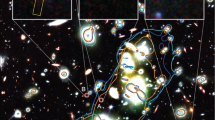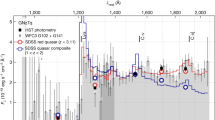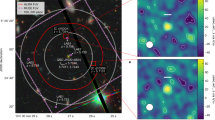Abstract
Blue compact dwarf (BCD) galaxies are low-luminosity (absolute K-band magnitude, MK > −21 mag)1, metal-poor (1/50 ≤ Z/Z⊙ ≤ 1/2, where Z is the metallicity in terms of the solar metallicity Z⊙)2, centrally concentrated3 galaxies with bright clumps of star formation4. Cosmological surface-brightness dimming5 and the small size of BCDs limit their detection at high redshifts, making their formation process difficult to observe. Observations of BCDs are needed at intermediate redshifts, where they are still young enough to show their formative stages, particularly in the outer regions where cosmic gas accretion should drive evolution. Here we report the observation of excess far-ultraviolet (FUV) emission in the outer regions of 11 BCDs in the GOODS South field at redshifts between 0.1 and 0.24, corresponding to look-back times of 1.3–2.8 billion years in standard cosmology. These observations were made by the Ultra-Violet Imaging Telescope6 on AstroSat7. For ten BCDs, the radial profiles of the intrinsic FUV emission, corrected for the instrument point spread function, have larger scale lengths than their optical counterparts observed with the Hubble Space Telescope. Such shallow FUV profiles suggest extended star formation in cosmically accreting disks. Clumpy structure in the FUV also suggests that the outer FUV disks are gravitationally unstable. Dynamical friction on the clumps drives them inwards at an average rate exceeding 106 solar masses per billion years.
This is a preview of subscription content, access via your institution
Access options
Access Nature and 54 other Nature Portfolio journals
Get Nature+, our best-value online-access subscription
$29.99 / 30 days
cancel any time
Subscribe to this journal
Receive 51 print issues and online access
$199.00 per year
only $3.90 per issue
Buy this article
- Purchase on Springer Link
- Instant access to full article PDF
Prices may be subject to local taxes which are calculated during checkout




Similar content being viewed by others
Data availability
The HST imaging data are available at https://archive.stsci.edu/hlsps/hlf/v1.5/ and the 3D-HST catalogue is available at https://3dhst.research.yale.edu/Data.php. The HAWK-I Ks band data are available at the ESO Science Archive Facility (http://archive.eso.org/scienceportal/home). The original level 1 far-UV data observed by UVIT/AstroSat are available for download from the ISSDC site at https://astrobrowse.issdc.gov.in/astro_archive/archive/Home.jsp.
Code availability
We have used standard data reduction tools in Python, IRAF, and the publicly available code SExtractor (https://www.astromatic.net/software/sextractor) and PROFILER (https://github.com/BogdanCiambur/PROFILER/) for this study. We also have used the MPFIT routine translated to Python language here (https://people.ast.cam.ac.uk/rcooke/python/packages/mpfit.py). The pipeline used to process the Level 1 AstroSat/UVIT data can be downloaded from http://astrosat-ssc.iucaa.in.
References
Gil de Paz, A., Madore, B. F. & Pevunova, O. Palomar/Las Campanas imaging atlas of blue compact dwarf galaxies. I. Images and integrated photometry. Astrophys. J. Suppl. Ser. 147, 29–59 (2003).
Kunth, D. & Östlin, G. The most metal-poor galaxies. Astron. Astrophys. Rev. 10, 1–79 (2000).
Hunter, D. A. & Elmegreen, B. G. Broadband imaging of a large sample of irregular galaxies. Astrophys. J. Suppl. Ser. 162, 49–79 (2006).
Östlin, G. et al. The source of leaking ionizing photons from Haro 11: clues from HST/COS spectroscopy of knots A, B, and C. Astrophys. J. 912, 155 (2021).
Calvi, V., Stiavelli, M., Bradley, L., Pizzella, A. & Kim, S. The effect of surface brightness dimming in the selection of high-z galaxies. Astrophys. J. 796, 102 (2014).
Tandon, S. N. et al. In-orbit performance of UVIT and first results. J. Astron. Astrophys. 38, 28 (2017).
Singh, K. P. et al. ASTROSAT mission. Proc. SPIE 9144, 91441S (2014).
Hunter, D. A. et al. The outer disks of dwarf irregular galaxies. Astron. J. 142, 121 (2011).
Lian, J. H., Kong, X., Jiang, N., Yan, W. & Gao, Y. L. Surface brightness profiles of blue compact dwarf galaxies in the GOODS-N and GOODS-S field. Mon. Not. R. Astron. Soc. 451, 1130–1140 (2015).
Galametz, A. et al. CANDELS multiwavelength catalogs: source identification and photometry in the CANDELS UKIDSS Ultra-deep Survey field. Astrophys. J. Suppl. Ser. 206, 10 (2013).
Schlafly, E. F. & Finkbeiner, D. P. Measuring reddening with Sloan Digital Sky Survey stellar spectra and recalibrating SFD. Astrophys. J. 737, 103 (2011).
Boyle, B. J., Shanks, T. & Peterson, B. A. The evolution of optically selected QSOs—II. Mon. Not. R. Astron. Soc. 235, 935–948 (1988).
Herrmann, K. A., Hunter, D. A. & Elmegreen, B. G. Surface brightness profiles of dwarf galaxies. I. Profiles and statistics. Astron. J 146, 104 (2013).
Thilker, D. A. et al. A search for extended ultraviolet disk (XUV-disk) galaxies in the local Universe. Astrophys. J. Suppl. Ser. 173, 538 (2007).
Kennicutt, R. C. & Evans, N. J. Star formation in the Milky Way and nearby galaxies. Ann. Rev. Astron. Astrophys. 50, 531–608 (2012).
Hunter, D. A., Elmegreen, B. G. & Ludka, B. C. GALEX ultraviolet imaging of dwarf galaxies and star formation rates. Astron. J 139, 447–475 (2010).
Jáchym, P., Combes, F., Cortese, L., Sun, M. & Kenney, J. D. P. Abundant molecular gas and inefficient star formation in intracluster regions: ram pressure stripped tail of the Norma galaxy ESO137-001. Astrophys. J. 792, 11 (2014).
Dessauges-Zavadsky, M., Verdugo, C., Combes, F. & Pfenniger, D. CO map and steep Kennicutt–Schmidt relation in the extended UV disk of M 63. Astron. Astrophys. 566, A147 (2014).
Bicalho, I. C., Combes, F., Rubio, M., Verdugo, C. & Salome, P. ALMA CO(2–1) observations in the XUV disk of M83. Astron. Astrophys. 623, A66 (2019).
Hunter, D. A. et al. LITTLE THINGS. Astron. J 144, 134–163 (2012).
Leitherer, C. et al. Starburst99: synthesis models for galaxies with active star formation. Astrophys. J. Suppl. 123, 3–40 (1999).
Elmegreen, D. M. et al. Clumpy galaxies in goods and gems: massive analogs of local dwarf irregulars. Astrophys. J. 701, 306–329 (2009).
Bell, E. & de Jong, R. S. Stellar mass-to-light ratios and the Tully–Fisher relation. Astrophys. J. 550, 212–229 (2001).
Elmegreen, B. G., Zhang, H.-X. & Hunter, D. A. In-spiraling clumps in blue compact dwarf galaxies. Astrophys. J. 747, 105–114 (2012).
Binney, J. & Tremaine, S. Galactic Dynamics (Princeton Univ. Press, 2008)
Ceverino, D., Dekel, A. & Bournaud, F. High-redshift clumpy discs and bulges in cosmological simulations. Mon. Not. R. Astron. Soc. 404, 2151–2169 (2010).
Zhang, H.-X., Hunter, D. A., Elmegreen, B. G., Gao, Y. & Schruba, A. Outside-in shrinking of the star-forming disk of dwarf irregular galaxies. Astron. J 143, 47 (2012).
Schulte-Ladbeck, R. E., Hopp, U., Crone, M. M. & Greggio, L. A stellar population gradient in VII Zw 403: implications for the formation of blue compact dwarf galaxies. Astrophys. J. 525, 709–719 (1999).
Momcheva, I. G. et al. The 3D-HST Survey: Hubble Space Telescope WFC3/G141 grism spectra, redshifts, and emission line measurements for 100,000 galaxies. Astrophys. J. Suppl. Ser. 225, 27 (2016).
Boissier, S. et al. The GALEX Ultraviolet Virgo Cluster Survey (GUViCS). II. Constraints on star formation in ram-pressure stripped gas. Astron. Astrophys. 545, A142 (2012).
Oke, J. B. Absolute spectral energy distributions for white dwarfs. Astrophys. J. Suppl. Ser. 27, 21 (1974).
Skelton, R. E. et al. 3D-HST WFC3-selected photometric catalogs in the five CANDELS/3D-HST fields: photometry, photometric redshifts, and stellar masses. Astrophys. J. Suppl. Ser. 214, 24 (2014).
Illingworth, G. et al. The Hubble Legacy Fields (HLF-GOODS-S) v1.5 data products: combining 2442 orbits of GOODS-S/CDF-S region ACS and WFC3/IR images. Preprint at https://arxiv.org/abs/1606.00841 (2016).
Fontana, A. et al. The HAWK-I UDS and GOODS Survey (HUGS): survey design and deep K-band number counts. Astron. Astrophys. 570, A11 (2014).
Saha, K. et al. AstroSat detection of Lyman continuum emission from a z = 1.42 galaxy. Nat. Astron. 4, 1185–1194 (2020).
Xu, C. Kevin et al. Number counts of GALEX sources in far-ultraviolet (1530 Å) and near-ultraviolet (2310 Å) bands. Astrophys. J. Lett. 619, L11–L14 (2005).
Bertin, E. & Arnouts, S. SExtractor: software for source extraction. Astron. Astrophys. Suppl. Ser. 117, 393–404 (1996).
Schlegel, D. J., Finkbeiner, D. P. & Davis, M. Maps of dust infrared emission for use in estimation of reddening and cosmic microwave background radiation foregrounds. Astrophys. J. 500, 525–553 (1998).
Bianchi, L. GALEX and star formation. Astron. Space. Sci. 335, 51–60 (2011).
Tody, D. The IRAF data reduction and analysis system. Proc. SPIE 627, 733 (1986).
Jedrzejewski, R. I. CCD surface photometry of elliptical galaxies. I—Observations, reduction and results. Mon. Not. R. Astron. Soc. 226, 747–768 (1987).
Ciambur, B. C. PROFILER—a fast and versatile new program for decomposing galaxy light profiles. Pub. Astron. Soc. Aus. 33, e062 (2016).
Erwin, P., Pohlen, M. & Beckman, J. E. The outer disks of early-type galaxies. I. Surface-brightness profiles of barred galaxies. Astron. J. 135, 20–54 (2008).
Markwardt, C. B. Non-linear least-squares fitting in IDL with MPFIT. In Astronomical Data Analysis Software and Systems XVIII ASP Conference Series Vol. 411 (eds Bohlender, D. et al.) 251–254 (ASP, 2009).
Moré, J. J., Garbow, B. S. & Hillstrom, K. E. Testing unconstrained optimization software. ACM Trans. Math. Softw. 7, 17–41 (1981).
Salpeter, E. E. The luminosity function and stellar evolution. Astrophys. J. 121, 161 (1955).
Calzetti, D. et al. The dust content and opacity of actively star-forming galaxies. Astrophys. J. 533, 682–695 (2000).
Akhlaghi, M. Carving out the low surface brightness Universe with Noise Chisel. Preprint at https://arxiv.org/abs/1909.11230 (2019).
Hathi, N. P., Mobasher, B., Capak, P., Wang, W.-H. & Ferguson, H. C. Near-infrared survey of the GOODS-North field: search for luminous galaxy candidates at z > ~6.5. Astrophys. J. 757, 43 (2012).
Reddy, N. A. et al. The HDUV Survey: a revised assessment of the relationship between UV slope and dust attenuation for high-redshift galaxies. Astrophys. J. 853, 56 (2018).
Zeimann, G. R. et al. The dust attenuation curve versus stellar mass for emission line galaxies at z ~ 2. Astrophys. J. 814, 162 (2015).
Bouwens, R. J. et al. ALMA spectroscopic survey in the Hubble Ultra Deep Field: the infrared excess of UV-selected z = 2–10 galaxies as a function of UV-continuum slope and stellar mass. Astrophys. J. 833, 72 (2016).
Papaderos, P. et al. The blue compact dwarf galaxy I Zw 18: a comparative study of its low-surface-brightness component. Astron. Astrophys. 393, 461–483 (2002).
Acknowledgements
This paper uses the data from the AstroSat mission of the Indian Space Research Organisation (ISRO), archived at the Indian Space Science Data Centre (ISSDC). The far- and near-UV observations were carried out by UVIT, which was built in collaboration between IIA, IUCAA, TIFR, ISRO and CSA. A.B. acknowledges the support of the DST-INSPIRE Fellowship programme by the Government of India. A.B. and R.G. thank the IUCAA associateship programme for their support and hospitality. K.S. and F.C. acknowledge the support of CEFIPRA-IFCPAR grant through the project number 5804-1 during its initial phase.
Author information
Authors and Affiliations
Contributions
A.B. contributed to the data acquisition, analysis, figures and writing. K.S. conceptualized the overall project, reduced the UVIT raw data with the L2 pipeline, and contributed to analysis and writing. B.E. contributed to the analysis and writing. R.G., F.C. and S.N.T. participated actively in the scientific discussion and interpretation throughout the project, and provided critical inputs to the manuscript.
Corresponding authors
Ethics declarations
Competing interests
The authors declare no competing interests.
Peer review
Peer review information
Nature thanks the anonymous reviewers for their contribution to the peer review of this work. Peer reviewer reports are available.
Additional information
Extended data
is available for this paper at https://doi.org/10.1038/s41586-022-04905-9.
Publisher’s note Springer Nature remains neutral with regard to jurisdictional claims in published maps and institutional affiliations.
Extended data figures and tables
Extended Data Fig. 1 Imaging of BCD sample.
Same as Fig. 1 (a,b,d,e) but for the rest of the BCDs in our sample (see ED Fig. 1 for the rest of the BCDs). Individual panel sizes are 15”x15”, except GS12–18”x18”. We include the XUV disk type, if qualified, for each BCD in the lower left corner of each panel. We find a total of 6 sources (orange boxes) having S/N ≥ 3 and without any HST counterpart outside the XUV region of the BCDs. Colour bar label is flux in counts per second.
Extended Data Fig. 3 Test for clump significance.
a. Patch of sky of size 341 × 341 pixels devoid of bright and large sources in the GOODS South field. Red circles denote sources having S/N ≥ 3 and their number is 49. Of these, 13 are marked with black circles that do not have any HST counterpart . b. S/N histogram of sources detected in the patch shown in a. Panel c, e GS3 and GS6 with the same size as presented in Fig. 1. Cyan circles and boxes mark the SExtractor-detected sources. Sources having S/N < 3 are marked with cyan circles. Sources having S/N ≥ 3 and HST counterparts are marked with cyan dashed squares. The orange square has S/N ≥ 3 and no HST counterpart. Magenta circles mark noise dips below a flux value of zero. Panel d, f represent flux (measured within a fixed aperture of size 0.7” radius) histograms corresponding to panel c, e.
Rights and permissions
About this article
Cite this article
Borgohain, A., Saha, K., Elmegreen, B. et al. Extended far-ultraviolet emission in distant dwarf galaxies. Nature 607, 459–462 (2022). https://doi.org/10.1038/s41586-022-04905-9
Received:
Accepted:
Published:
Issue Date:
DOI: https://doi.org/10.1038/s41586-022-04905-9
Comments
By submitting a comment you agree to abide by our Terms and Community Guidelines. If you find something abusive or that does not comply with our terms or guidelines please flag it as inappropriate.



